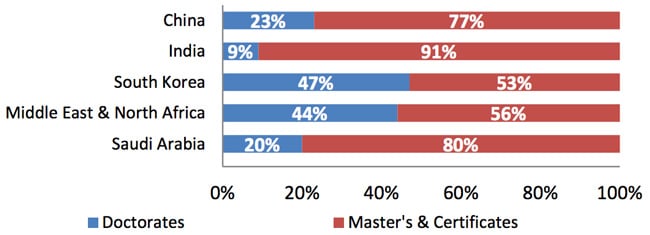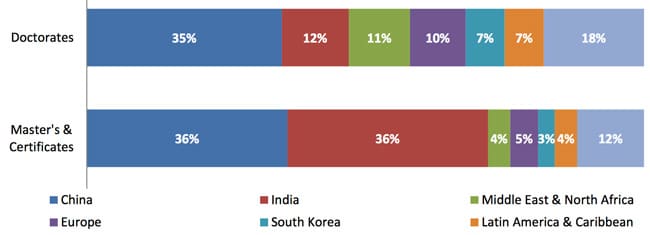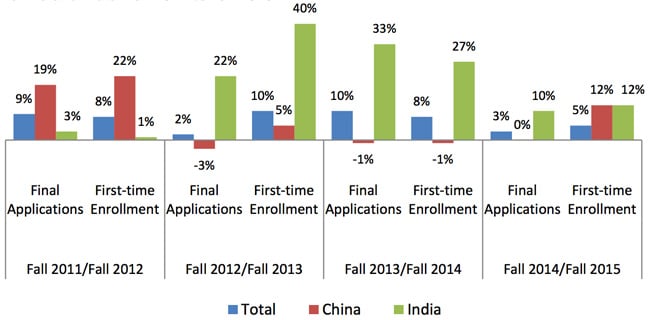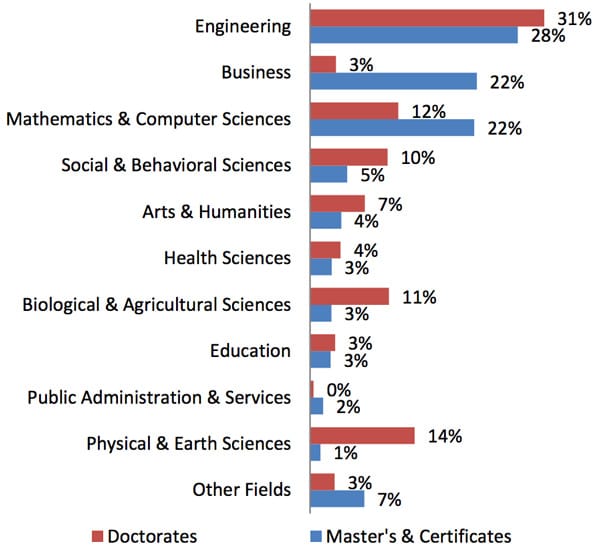New report finds slower growth for US graduate programmes in 2015
The latest report from the Council of Graduate Schools (CGS) finds that growth in international enrolment in US graduate studies has slowed. Applications and first-time enrolment by international graduate students in the US increased by 3% and 5% respectively between fall 2014 and fall 2015. This compares to corresponding growth rates of 10% and 8% between fall 2013 and fall 2014. This is one of the lead findings from International graduate applications and enrolment: Fall 2015, the latest in a series of survey reports from CGS. Released on 17 December 2015, the report is based on detailed admissions and enrolment data provided by 350 higher education institutions over September and October 2015. The report offers a number of important insights into the composition of international graduate enrolment in the US. Many observers, however, will pause at the news of declining growth rates over 2014 and 2015, and it will be important to see in subsequent surveys if this is the start of a trend toward lower growth rates for US graduate schools. For the moment, last year’s 5% increase in first-time international graduate enrolment is the slowest rate of growth over the three most-recent fall admissions cycles. The significance of this lies in the fact that even at recent lower growth rates, the rate of growth for first-time international graduate students was still greater than the 2% increase in domestic students for fall 2015. Indeed, previous CGS reports have indicated that international students have driven more than two-thirds of all growth for US graduate programmes over the past decade.
Any significant drop-off in growth rates for international enrolment, therefore, is likely to have a broader impact on overall US graduate admissions trends.
In total, the institutions responding to the 2015 CGS International Graduate Admissions Survey received over 1.6 million applications for graduate studies beginning in fall 2015. Nearly half of those (786,363 or 47% of the total) were submitted by prospective international students. The responding institutions issued 600,000 offers of admission for the fall 2015 admissions cycle with 215,156 of those (roughly 35%) going to international students. "Admission yield for international graduate students were lower than for that of US citizen/permanent resident graduate students," adds the report. "Institutions that participated in the 2015 survey enrolled over 300,000 graduate students for the first-time in fall 2015, and of those 84,323, or 26%, were international students." In other words, among the institutions responding to the survey, 786,363 international admissions applications for fall 2015 resulted in 215,156 offers of admission to prospective overseas students, and that in turn converted to 84,323 new international graduate students at US institutions.
Master’s degrees in the spotlight
The CGS report also highlights the fact that a majority of first-time international graduate students in the US are enrolled in master’s or post-graduate certificate programmes. Nearly eight in ten first-time students (77%) were enrolled in master’s or certificate programmes in fall 2015, as opposed to 23% in doctoral studies.
The overall breakdown of international enrolment remains somewhat more balanced, with 58% of all international graduate students in the US enrolled in master’s or certificate-level study and 42% in doctoral programmes.
As the following chart reflects, first-time Indian (91%) and Saudi Arabian (80%) graduate students were most likely to pursue master’s or certificate studies (closely followed by China with its 77% of students in master's or certificates), whereas 47% of students from South Korea were enrolled in doctoral programmes.

China and India continue to drive growth
Nearly eight out of ten (79%) international graduate applications for fall 2015 were submitted by Chinese or Indian students. As the following chart reflects, students from these leading source markets each accounted for 36% of first-time master’s and certificate enrolment in fall 2015. China again accounted for more than a third (35%) of all first-time international enrolment at the doctoral level, leading the next-closest sending country (India) by more than 20 percentage points.

These contrasting trends have contributed to another interesting observation from the report in that there are now more Indian students enrolled in master’s and certificate-level programmes in US (49,522) than there are Chinese students (44,335).
Given Indian students' demand for master's and certificate programmes, this may in turn also be playing an important role in the shift to master's and certificate study among first-time international graduate students in the US.
China, however, remains the leading source market for international graduate students in the US with a total of 76,440 students enrolled as of fall 2015 (as reporting by institutions responding to the CGS survey). We also see in the chart below that the Indian surge has eased for fall 2015, with both China and India recording the same 12% increase in first-time graduate enrolment.

Engineering still key
Engineering remains the most popular field of study for international graduate students in the US, accounting for nearly one-third (32%) of applications and nearly three in ten (29%) first-time international graduate enrolments in fall 2015.

















